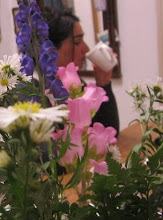Remembering Delhi
As this wave from memories flows in, the city soaks it up like a sponge and expands.Italo Calvino, Invisible Cities
A Chrono-topo-graphy of Imagination
Subhash Jaireth, a poet, born in india, describe his coming back to visit india after many years he was apsant (in order to meet his daughter, whom he didn't see for 5 years)- he is walking through the streets of Delhi, accompanied by maps and aided with histories both personal and formal, Jaireth revisits the city as an imaginative construct, an interplay of concrete and abstraction.

Delhi as it looked just before the Rebellion of 1857: CLICK FOR A LARGE SCAN . and more Delhi maps
"..in the anticipated journey to Delhi to see my daughter. That journey opened the way for the trips which I have taken to the Delhi of my childhood and youth, and also to that Delhi which I have imagined by reading, seeing, and listening to all that surrounds Delhi like a Benjamian "aura." As I write/walk each word/step takes me through the city of my memories.."

The Fatehpuri Masjid of Delhi 1840's
"In the past, first as a school boy and later as an academic, I had never felt the need of a map. The city always seemed familiar and homely. Often it felt like a big town, too chaotic to be contained within the limits of a map. On the Lonely Planet map, Delhi looks like a city. It has a shape, a structure, rationality defined by a neat pattern of straight roads, roundabouts, and green patches of boulevards, parks and gardens. The meandering blue outlines of the river Yamuna, painted along the eastern margin of the map, makes the city picturesque."

Bicycle rikshaw driver taking children home after school. New Delhi. via
"...Walking is one of those spatial practices through which people transform places into spaces by making them "their own" and by circumscribing them within their everyday living. "Walking," notes Michel de Certeau, "is to the urban system what the speech act is to language. Walking affirms, suspects, tries out, transgresses...it speaks." For de Certeau walking is equivalent to reading which produces a space by transforming a written text, "the place constituted by a system of signs." A similar thing has happened, and is happening now, as I write this essay, although instead of reading, I am engaged in the acts of remembering and writing. But as I write, I read the traces of my own walks. I write them for you and for myself. I have thus created a map for you to read and walk and transcribe your presence over the traces which I have left. As you read and walk through my Delhi, you traverse the mind scape of my memories. "
"..Maps, like stories, de-scribe and in-scribe places. Through them places are assimilated, owned and disowned, longed for and belonged to. In fact, stories, to use de Certeau's words, often simultaneously employ "map type" (at the western end of the Chandni Chowk) and "tour type" (you walk along the Chandni Chowk and turn right at the first intersection) descriptions. For de Certeau they represent two symbolic and anthropological languages of space. If map type descriptions present a tableau and focus on seeing, tour type tend to organise movements and focus on operations, actions, and itineraries. In stories, the two types intervene and punctuate each other's presence, conditioning as well as preparing ground for each other. "
he also mention the book 'INDIAN MAPS AND PLANS' : Susan Gole, 1989, New Delhi. that seems very interesting, i could only find one sample from her book. as well as 'The Delhi Book' by writen by Sir Thomas Metcalfe that while working in India as the Governor-General's Agent at the Imperial court of the Mughal Emperor, assembled an album containing 120 paintings by Indian artists. He wrote his own descriptive text alongside these paintings, and sent the precious 'Delhi Book' to his children in England.
The Resident Sir Thomas Metcalfe and his assistants taking part in the Mughal Emperor's procession to celebrate the 'Id festival. Metcalfe is the man seated on the red chair at the front. This detail shows merely one of the twelve panels that make up this painting.






2 comments:
nice post.
I like the thoughtful tone of this text. Where are our walking traces, left, Moon? Why right here on this blog.
Post a Comment